|
|

Baby Baby Sitter. Such scenes were common in those days. Mom and dad were both busy farming, leaving the baby in the hands of older children. Hand-colored.
|
|
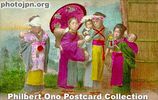
Young baby sitters. The girls look around 8 or 9 years old. The artist went slightly overboard with the hand coloring. Colorful, but too bold.
|
|

Child dancer. Postcard-size photograph. Date is unknown.
|
|

Girl on stage. Postcard-size photograph. Date is unknown.
|
|
|
|

Twins. They look like twins or sisters. Real-photo postcard postmarked 1918.
|
|

Autographed as Yoko Aozora. She must have been some kind of teenaged entertainer. Probably a dancer. Looks charming enough.
|
|

New Year's photo. The paper ball is for a traditional New Year's game. Postcard-size photograph.
|
|
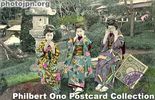
Speak, Hear, and See No Evil. A common pose imitating the monkeys. Postmarked 1914. Hand-colored.
|
|
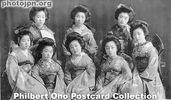
Young girls in kimono.
|
|

Oil-painted card of Mt. Fuji. This is my favorite oil-painted postcard in my collection. The artist painted a few other cards like it. The artist's name was not signed, unfortunately. But the painting style is distinct.I can't define what fine art is, but I know it when I see it.
|
|

Oil-painted card of Mt. Fuji 2. Another postcard oil painting of Mt. Fuji.
|
|

"Japs" on hand-painted Mt. Fuji card. The message on this card reads: "Fujiyama, the mt. (mountain) the Japs worship. Been seeing Yokohama in a jinrichisha (rickshaw). Feb. 14."This person apparently learned a few Japanese words like "jinrikisha" which means "human-powered vehicle" that is the rickshaw. And the term "Japs" has been around well before World War II.
|
|
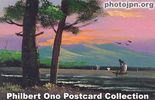
Painting by high school girl? This is my only oil-painted card that has a message and postmark (1910 from Nagasaki). It was addressed to a lady in Alameda, California and says in English that the card was hand painted by a Japanese high school girl.Whether this is true or not, I don't know. But the painting style of this card and the others you see here are the same. (I bought them as a set.)
|
|
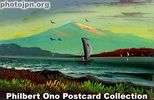
Oil-painted card of ocean and mountain. Apparently by the same artist as the preceding card.
|
|
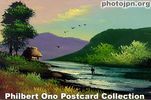
Oil-painted card of river. Apparently by the same artist as the preceding card.
|
|
|
|
|
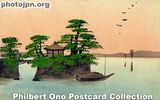
Oil-painted card of Matsushima. Matsushima is a picturesque group of pine tree islands near Sendai, Miyagi Pref. The island pictured is one of the main islands and a major tourist stop.Along with Amanohashidate in Kyoto and Miyajima in Hiroshima, Matsushima is known as one of the three most famous views of Japan (Nihon Sankei).
|
|
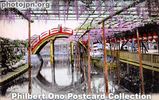
Kameido Tenmangu Shrine, Tokyo. Famous since the Edo Period for wisterias, this shrine has been a popular subject for woodblock artists and early photographers. The wisterias bloom around late April. The shrine is near Kameido Station on the Sobu Line.The shrine is near Kameido Station on the Sobu Line in Tokyo. Hand-colored.
|
|
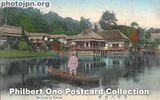
Tea house garden in Hikone, Shiga. This cozy Japanese garden has tea houses. It is directly behind Hikone Castle in Shiga Prefecture. Hikone Castle was the home of Naosuke Ii, the high official who met Commodore Perry.Today, this garden still looks pretty much the same. It was even used for a garden scene in the TV mini-series "Shogun." See photos here.
|
|
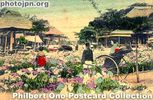
Iris Garden at Horikiri, Tokyo. This card is made of balsa wood. It shows a woman arriving at the garden in a rickshaw. I've seen this photo printed on paper postcards as well. The garden still exists in Tokyo and it's still famous for irises.See photos of the garden today. It's still famous for irises that bloom in June. Hand-colored postcard.
|
|
|
|
|
|